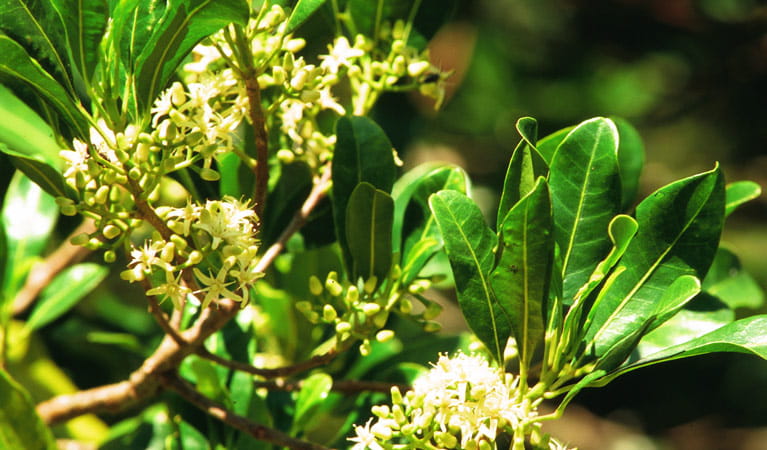Boorganna Nature Reserve
Overview
At Boorganna Nature Reserve, near Comboyne Village, you can go bushwalking through rainforest, birdwatch, picnic, see scenic views and waterfalls all while learning more about local Aboriginal history.
Read more about Boorganna Nature Reserve
Established in 1904, Boorganna Nature Reserve is the second-oldest nature reserve in all of NSW. It’s located on the southern edge of Comboyne Plateau and protects a significant remnant of rainforest, which once covered the entire landscape.
Take your time soaking up the beautiful and varied scenery here, which encompasses no less than six types of rainforest among nearly 400ha of diverse vegetation, ranging from eucalypt forest to luxuriant subtropical rainforest.
The reserve is popular with birdwatchers, as there are some 85 species you can encounter here. There’s lots of other wildlife to see, including interesting and vulnerable species you don’t often see elsewhere, such as long-nosed potoroos, parma wallabies, and yellow-bellied gliders.
Keen photographers will want to capture the impressive views you’ll encounter here, from sweeping panoramic views of the Great Dividing Range to the calm, green rolling hills of the plateau, as well as the lovely Rawson Falls with its dramatic 40m high falls.
Local alerts
For the latest updates on fires, closures and other alerts in this area, see https://www.nationalparks.nsw.gov.au/visit-a-park/parks/boorganna-nature-reserve/local-alerts
Contact
- in the North Coast region
Boorganna National Park is always open but may have to close at times due to poor weather or fire danger.
-
-
Port Macquarie office
02 6588 5555 for general enquiries only, no bookings.
Contact hours: Monday to Friday, 9am to 4.30pm. - 22 Blackbutt Road, Port Macquarie NSW 2444
-
Email: npws.hastingsmacleay@environment.nsw.gov.au
-
Port Macquarie office
Visitor info
All the practical information you need to know about Boorganna Nature Reserve.
Map
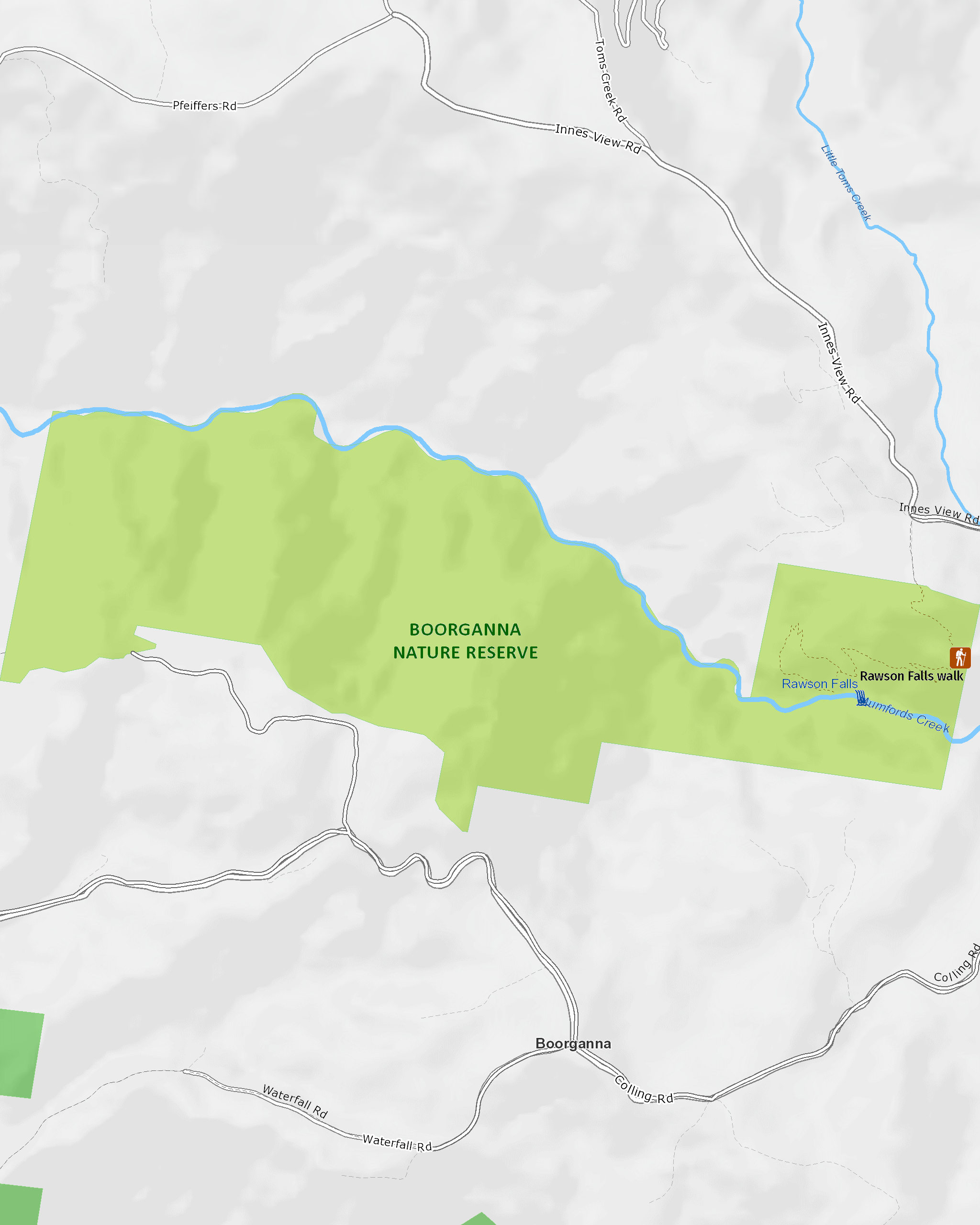
Map legend

Getting there and parking
Get driving directions
From Comboyne:
- Travel northwest from Comboyne along Comboyne Road . Turn right onto Innes View Road (3km), and then turn left at the entrance to the reserve (3km).
From Wauchope:
- Travel west on Oxley Highway. Turn left onto Comboyne Road (follow signs to Byabarra – 11km).
- Follow Comboyne Road (26.5km)
- Follow directions as for Comboyne
From Taree:
- Travel north-west on Wingham Road to Wingham (10km)
- Travel north on Comboyne Road towards Comboyne (39km)
- Turn left at Innes View Road and follow to the reserve entrance (3km).
By bike
Check out the Bicycle information for NSW website for more information.
By public transport
For information about public transport options, visit the NSW country transport info website.
Best times to visit
There are lots of great things waiting for you in Boorganna Nature Reserve. Here are some of the highlights.
Autumn
Autumn, with its mild temperatures, is a great season to bushwalk, picnic and enjoy the views from the waterfall and the brightly coloured fungi that are rampant in the rainforest at this time of year.
Spring
Spring is a great time for bushwalks and birdwatching when plants are flowering and fruiting. The reserve's birds are all highly active during this time too.
Summer
Summer is a good time to escape the heat and holiday crowds by exploring the hinterland. Walking in cool temperate rainforest can be a pleasant and calming escape on a hot summer day.
Winter
In winter, the reserve and the Comboyne Plateau create a picturesque winter wonderland destination for car touring, with its early morning frosts at high altitudes and crystal clear skies.
Weather, temperature and rainfall
Summer temperature
Average
17°C and 28°C
Highest recorded
42.2°C
Winter temperature
Average
7°C and 21°C
Lowest recorded
-1.5°C
Rainfall
Wettest month
January
Driest month
July
The area’s highest recorded rainfall in one day
234.6mm
Maps and downloads
Prohibited
Pets
Pets and domestic animals (other than certified assistance animals) are not permitted. Find out which regional parks allow dog walking and see the pets in parks policy for more information.
Smoking
NSW national parks are no smoking areas.
Nearby towns
Wingham (41 km)
A short stroll from the centre of Wingham is Wingham Brush Nature Reserve. Here you'll see a major colony of grey-headed flying foxes hanging head-down in the canopies of 1000-year-old Moreton Bay and strangler figs.
Wauchope (44 km)
Wauchope is great base for exploring nearby national parks that are part of the Gondwana Rainforests of Australia World Heritage Area. Follow the Hastings Forest Way to Werrikimbe National Park, a rugged wilderness of outstanding beauty spread with short and long walks. Willi Willi National Park is a rainforest mountain park with three beautiful walking tracks that follow the river and lead to a sparkling waterfall.
Taree (92 km)
Taree is a major mid North Coast city, ringed by superb beaches. It's situated on the Manning River and set against rolling hills.
Learn more
Boorganna Nature Reserve is a special place. Here are just some of the reasons why:
Traditional Aboriginal lands
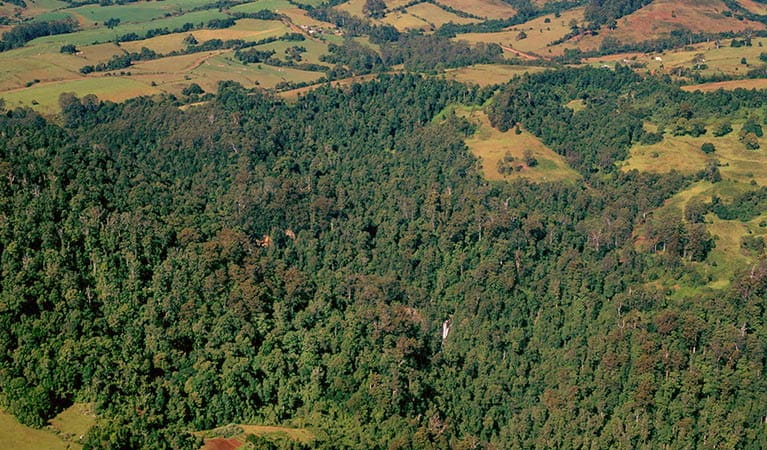
The traditional Aboriginal custodians of the reserve and surrounding area are the Birpai People, who once used the rainforests for a variety of important cultural purposes, such as gathering plants and animals for food and medicine. The origin of the name 'Boorganna' is uncertain, though it is thought that it refers to either the mahogany or lilly pilly trees that thrive in this area. The name 'Comboyne' is derived from 'Wambuyn', meaning 'the place of kangaroos', and indeed you're likely to spot many of these fascinating native creatures bounding along the plateau, particularly at dawn and dusk.
Preserving for the future
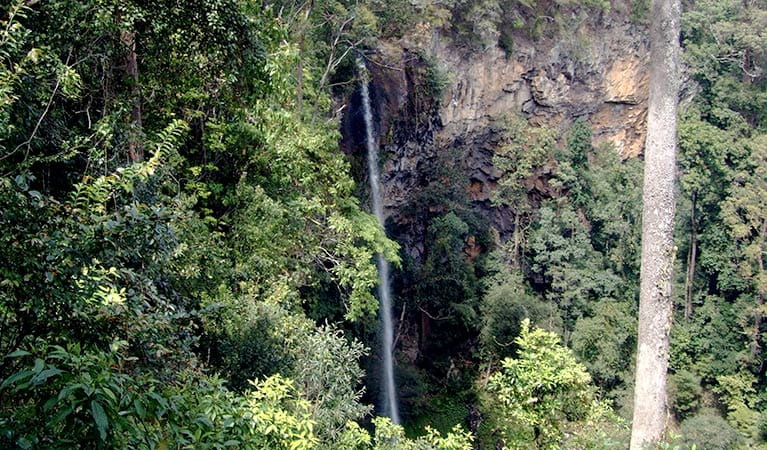
Boorganna Nature Reserve is the second-oldest nature reserve in NSW and an important reminder of the extensive rainforest that once covered the entire Comboyne Plateau. Its deep red fertile soils are ideal for the rainforest and moist hardwood forests that grow here. In 1904, a small area around Rawson Falls was dedicated to the preservation of native flowers and public recreation.
- Rawson Falls walk Follow Rawson Falls walk all the way to the scenic waterfalls, passing a lookout, picnic area and swimming hole, while enjoying birdwatching and wildlife along the way.
A natural haven
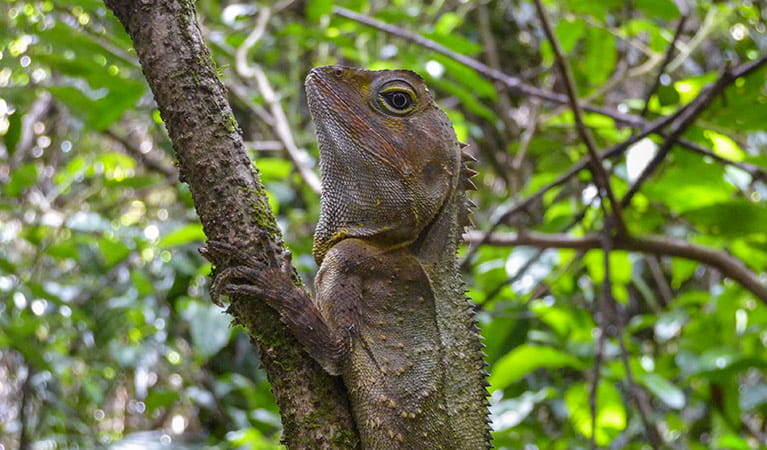
Boorganna Nature Reserve has one of the most botanically diverse environments you're likely to encounter in NSW, with 6 types of forest, including subtropical, warm temperate, gully rainforest and wet and dry sclerophyll forest. The reserve forms part of the Tapin Tops/Killabakh regional wildlife corridor which protects a number of vulnerable species, including yellow-bellied gliders, long-nosed potoroos, parma wallabies, rufous scrub birds and Stephen's banded snake. Other unique animals recorded here include the spotted-tailed quoll, red-necked pademelon, swamp wallaby, and long-nosed bandicoot. Around 85 bird species also call this area home, including 2 vulnerable owls (the masked owl and sooty owl), and other threatened species such as rose robins, yellow-throated scrub wren, crimson rosellas, superb lyrebirds and scarlet honeyeaters.
- Rawson Falls walk Follow Rawson Falls walk all the way to the scenic waterfalls, passing a lookout, picnic area and swimming hole, while enjoying birdwatching and wildlife along the way.
Winged paradise
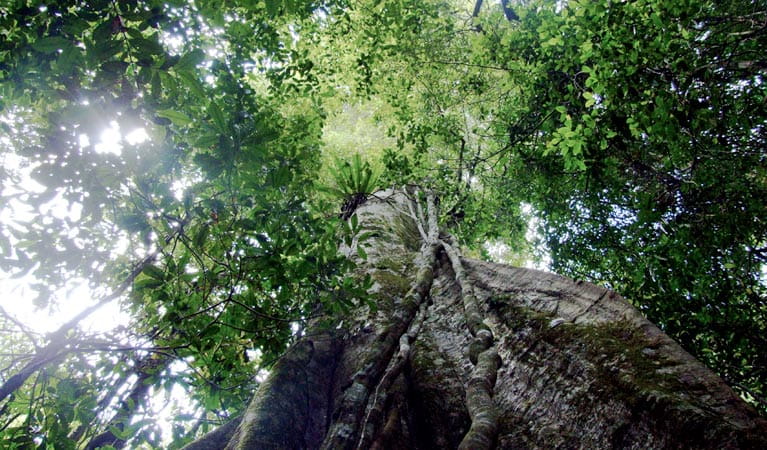
Be sure to bring your binoculars, because bird watching is one of the reserve’s most rewarding activities, thanks to the 85 species that call this area home. In addition to two vulnerable owls (the masked owl and sooty owl), other threatened species that find sanctuary here include rose robins, yellow-throated scrubwren, crimson rosellas, superb lyrebirds, scarlet honeyeaters, and many more.
- Rawson Falls walk Follow Rawson Falls walk all the way to the scenic waterfalls, passing a lookout, picnic area and swimming hole, while enjoying birdwatching and wildlife along the way.
Education resources (1)
What we're doing
Boorganna Nature Reserve has management strategies in place to protect and conserve the values of this park. Visit the OEH website for detailed park and fire management documents.

